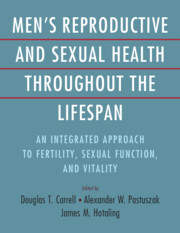 Men's Reproductive and Sexual Health Throughout the Lifespan
Men's Reproductive and Sexual Health Throughout the Lifespan Book contents
- Men’s Reproductive and Sexual Health throughout the Lifespan
- Men’s Reproductive and Sexual Health throughout the Lifespan
- Copyright page
- Contents
- Contributors
- Preface
- Section 1 An Introduction to Men’s Health Care
- Chapter 1 How Has Men’s Health Changed over the Past Two Decades?
- Chapter 2 The Business Landscape of Men’s Health
- Chapter 3 Urologic Men’s Health, the Internet, and Social Media
- Section 2 The Biology of Male Reproduction and Infertility
- Section 3 Clinical Evaluation and Treatment of Male Infertility
- Section 4 Laboratory Evaluation and Treatment of Male Infertility
- Section 5 Medical and Surgical Management of Issues of Male Health
- Index
- References
Chapter 3 - Urologic Men’s Health, the Internet, and Social Media
from Section 1 - An Introduction to Men’s Health Care
Published online by Cambridge University Press: 06 December 2023
- Men’s Reproductive and Sexual Health throughout the Lifespan
- Men’s Reproductive and Sexual Health throughout the Lifespan
- Copyright page
- Contents
- Contributors
- Preface
- Section 1 An Introduction to Men’s Health Care
- Chapter 1 How Has Men’s Health Changed over the Past Two Decades?
- Chapter 2 The Business Landscape of Men’s Health
- Chapter 3 Urologic Men’s Health, the Internet, and Social Media
- Section 2 The Biology of Male Reproduction and Infertility
- Section 3 Clinical Evaluation and Treatment of Male Infertility
- Section 4 Laboratory Evaluation and Treatment of Male Infertility
- Section 5 Medical and Surgical Management of Issues of Male Health
- Index
- References
Summary
The internet constantly evolves and facilitates the development of new avenues for users to interact and communicate internationally. Social media and search engines represent the forefront of internet technologies that enable users to produce content, develop digital participatory networks, and share information across various topics. These internet tools are reshaping the continuum of care by enabling patients to acquire medical information, consult peers and healthcare practitioners, and even make treatment decisions without leaving their connected device. The consequences of circumventing traditional pathways to care are amplified in men’s health due to the fact that men frequently do not engage with the healthcare system and that erectile dysfunction and male infertility are stigmatized. The focus of this chapter is to evaluate the emerging online landscape for common men’s health conditions including male infertility, erectile dysfunction, hypogonadism, and Peyronie’s disease.
Keywords
- Type
- Chapter
- Information
- Men's Reproductive and Sexual Health Throughout the LifespanAn Integrated Approach to Fertility, Sexual Function, and Vitality, pp. 16 - 22Publisher: Cambridge University PressPrint publication year: 2023


